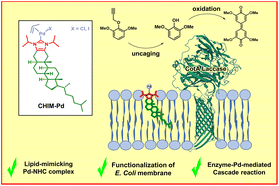Combining lipid-mimicking-enabled transition metal and enzyme-mediated catalysis at the cell surface of E. coli†
Abstract
Being an essential multifunctional platform and interface to the extracellular environment, the cell membrane constitutes a valuable target for the modification and manipulation of cells and cellular behavior, as well as for the implementation of artificial, new-to-nature functionality. While bacterial cell surface functionalization via expression and presentation of recombinant proteins has extensively been applied, the corresponding application of functionalizable lipid mimetics has only rarely been reported. Herein, we describe an approach to equip E. coli cells with a lipid-mimicking, readily membrane-integrating imidazolium salt and a corresponding NHC–palladium complex that allows for flexible bacterial membrane surface functionalization and enables E. coli cells to perform cleavage of propargyl ethers present in the surrounding cell medium. We show that this approach can be combined with already established on-surface functionalization, such as bacterial surface display of enzymes, i.e. laccases, leading to a new type of cascade reaction. Overall, we envision the herein presented proof-of-concept studies to lay the foundation for a multifunctional toolbox that allows flexible and broadly applicable functionalization of bacterial membranes.



 Please wait while we load your content...
Please wait while we load your content...